The ‘smart and cheeky’ Aboriginal boy teaching Australia a lesson
Posted on May 9th, 2021
By Vibeke Venema BBC News
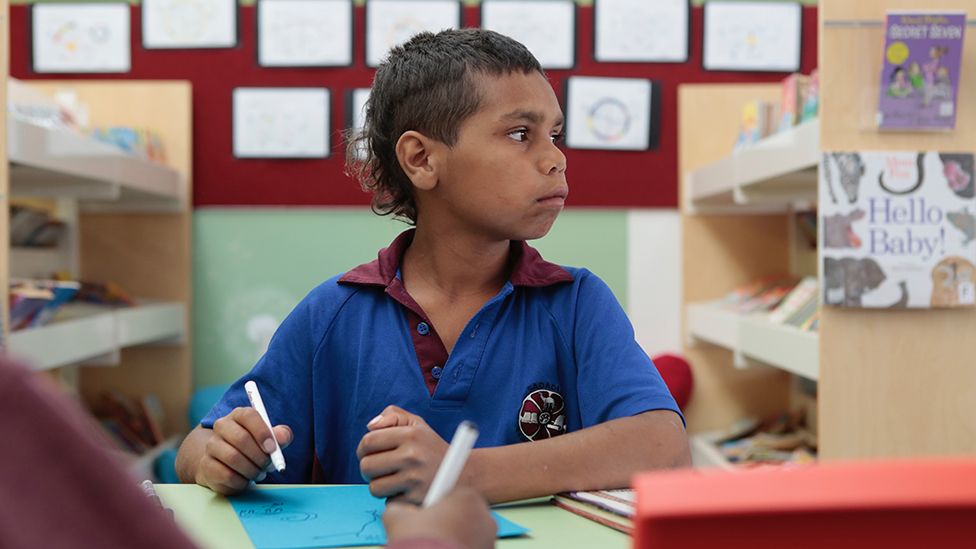
A documentary about a 10-year-old Aboriginal boy’s experience in school, In My Blood It Runs, has reignited a debate about Australia’s failure to give indigenous children a good education and a fair start in life.
“Listen carefully,” the teacher tells the class. “This one isn’t a story, this is information, or non-fiction – it’s fact.”
She’s holding up The Australia Book, a picture book from 1952, and reads: “In Botany Bay, Cook landed for the first time in a new country. Then he sailed up the coast, mapping as he went… On an island in Cape York he raised the English flag. And he claimed for the English country the whole of this new land.”
Dujuan Hoosan’s hand shoots up, but he doesn’t get the chance to speak.
Afterwards, the children have to find a list of words in the text and mark them with a highlighter. Dujuan, a 10-year-old Aboriginal boy, struggles a bit with the vocabulary, but he finds it even harder to recognise the story, because the history he has been taught by his elders is very different.
“That [lesson] was for white people, not for Aboriginals,” he reflects. “This man came on the ship and he was the first white man on Australia. The Aboriginal people told them to go and find another land, because this was their land. But people didn’t listen.”
Film-maker Maya Newell filmed the scene for her documentary, In My Blood It Runs – in which she followed Dujuan at school for a year – and could feel his frustration.
“You imagine what it feels like to be essentially erased from history,” she says.

Maya and Dujuan first met “out bush” when Maya was filming a story-telling session in one of the red-earth deserts of central Australia. Sitting around a campfire at night, a rapt group of Aboriginal children listened as aunts and grandmothers told stories in the Arrernte language about how the world began and about their connection to the land.
Dujuan was an eager learner. He had already got to know quite a few plants with medicinal properties, and told Maya about his healing gift: when his family had aches and pains it was his job to lay hands on them, he said, using powers that had passed to him after his great-grandad died.
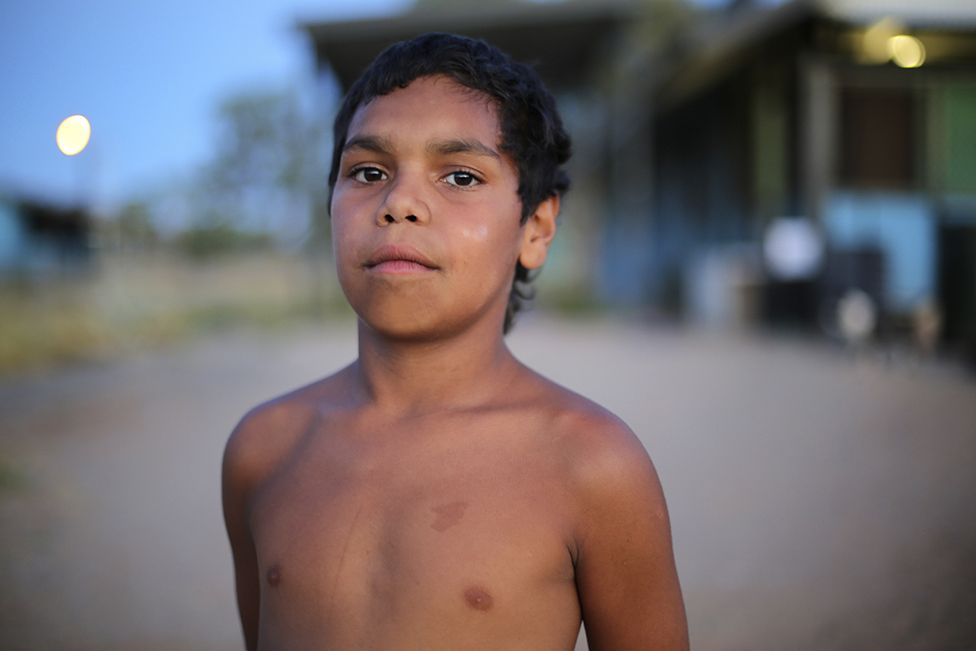
Maya was struck by the unusually confident and articulate 10-year-old. When Dujuan said she should make a film about him, she asked his family, and they agreed. They wanted to shine a light on the difficulties Aboriginal families face in Australian schools, and they trusted Maya, who had been working with their community for more than a decade, making educational films and archiving songlines (an ancient way of passing on laws and knowledge).
Maya began to spend two or three days a week with Dujuan’s family – his mother, grandmother and two brothers – recording day-to-day life in the Hidden Valley Aboriginal Town Camp, on the outskirts of Alice Springs. Some days there was no milk, so the boys ate breakfast at school. Some nights there was no electricity, so they played I-spy under the stars.
About 20% of the town’s 30,000 residents are Aboriginal, and most of them live in heavily-policed, run-down camps that sprang up in the 1960s, when many Aboriginal people were forced off their land.
“You grew up around drunks, smoking – then you start learning from that,” says Dujuan’s mum, Megan. She was expelled from school at 14, so her parents sent her to stay with aunties in the safety of the countryside in Borroloola, 1,260km (780 miles) north. That’s where she met Dujuan’s dad, James, who came back with her to Alice Springs with their first child, but left when they broke up, a few years after Dujuan was born.
“Being a teenage parent is hard, and being an Aboriginal mum is exhausting,” Megan says. “Every day you hear that you are not good enough – in the newspapers, on TV, on social media.”
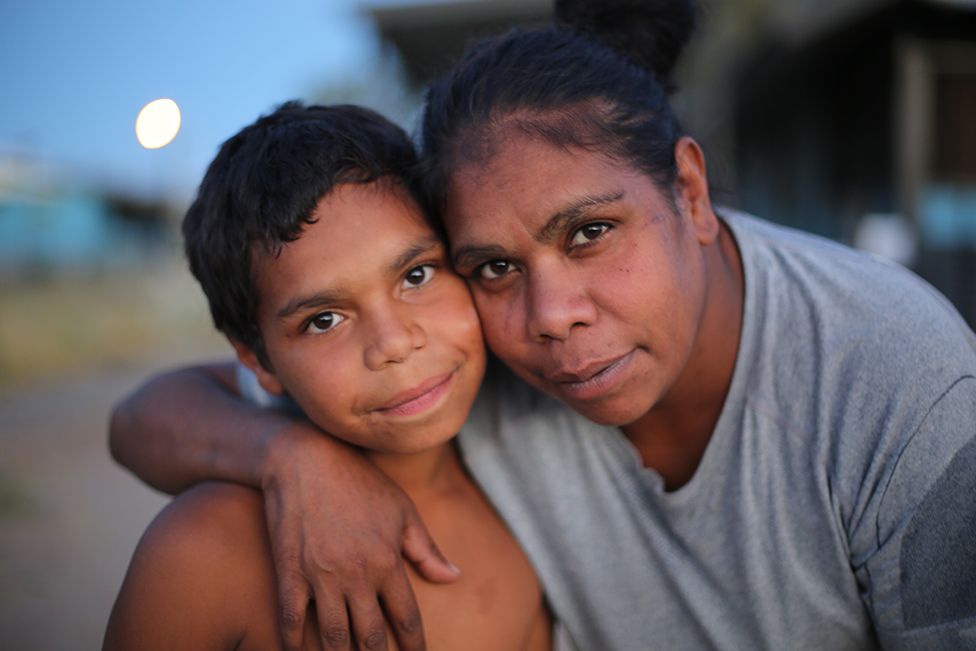
She worries about her children getting into trouble, like she did, particularly “smart and cheeky” Dujuan. And as filming progresses, her fears are realised.
One day a teacher reads the class a picture book of the Dreamtime, the Aboriginal story of how the world began. It’s an effort to teach Aboriginal culture, but it’s not a great success. The teacher seems puzzled. “So they’re actually saying there’s a spirit?” she asks.
Dujuan reacts with emotion: “The spirit is real, man!”
When his report card arrives he gets very upset. He has the lowest grade – E – for every subject. He thinks there must be something wrong with him.
Soon afterwards, he gets angry and smashes a window; he is sent home and risks being suspended. He also starts skipping school, and this could have serious consequences – under strict rules brought in with the aim of improving educational outcomes for Aboriginal children, attendance is directly linked to income support and family assistance. If children are regularly absent, their parents’ welfare payments can be stopped. It also increases their risk of being taken into care.

Australia’s “national shame”
- In 2008 the Australian government pledged to “close the gap” in outcomes for indigenous and non-indigenous people in terms of life expectancy, child mortality, education and employment
- Last year the government acknowledged that most of the seven targets had not been met – which Prime Minister Scott Morrison described as a “national shame”
- Seventeen new targets have now been set, in partnership with Aboriginal and Torres Strait Islander groups
- It remains the case, though, that young indigenous people are 17 times more likely to be jailed than their non-indigenous counterparts (43 times more likely in the Northern Territory) and that a young indigenous man is more likely to be in prison than university

When Dujuan doesn’t come home from school one day, his mum and grandma go out looking for him until late in the night. If the police find him first, they will report it to welfare, and he could end up in foster care – or worse, juvenile detention.
“You know, your little age is the right age to go to juvenile centre,” Megan warns him.
Aboriginal and Torres Strait Islander children are vastly over-represented in the Australian penal system. Nationwide, they make up close to 70% of those aged 10-14 in youth detention, despite being only about 6% of the population in that age group. In the Northern Territory, in which Alice Springs is located, the situation is even worse: at the end of March, 31 out of 33 young people in detention (94%) were Aboriginal.
“Trust me, juvenile is not a good place to be,” Dujuan’s aunt Alexis tells him. “You’re only going to end up in two places: a jail cell, or a coffin.”
“What’s a coffin?” asks Dujuan.
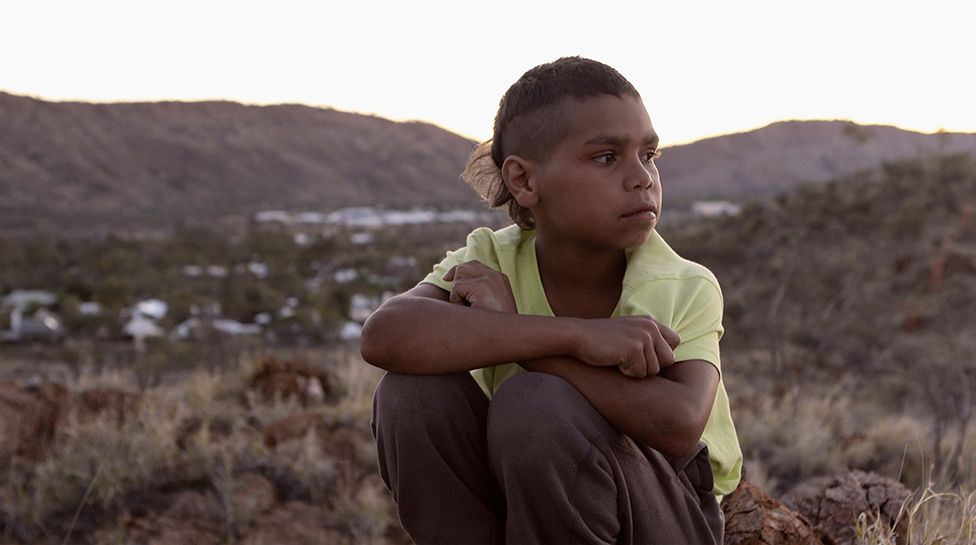
Dujuan’s family move him to a different primary school, one that offers a bilingual curriculum. But he skips classes here too, and his late-night adventures on the streets of Alice Springs continue.
He’s picked up by the police several times, and gets formal warnings that if he’s found causing a nuisance again he’ll be sent to juvenile detention, or taken into care.
“This is what happens to young boys in Alice Springs. This is the story of what it is to be a First Nations child in this country,” Maya Newell says.
Finally, after stealing a teacher’s car keys and throwing them on the school roof, Dujuan is expelled.

The Northern Territory department of education says its schools are supported to deliver the Australian curriculum framework in a “culturally responsive and engaging way” acknowledging the “rich culture and diversity” of the community.
It says schools can opt to use an “indigenous languages and cultures curriculum”, including tuition in any of 30 languages, and that they are encouraged to share decision-making with families, communities and industry partners.
But Dujuan’s family never felt these good intentions were reflected in the classroom.
“White people educate our kids in the way they want them to be educated, but I need [our kids] to speak the language,” says Dujuan’s grandmother, Carol.

Within living memory it was government policy to break the link between children and their Aboriginal ancestors and culture and to assimilate them into the white population.
Dujuan has grown up with stories of children being taken away to be brought up by white families. One of his great-grandmothers was taken, while another was hidden “way out bush” for safety.
William Tilmouth, chair of Children’s Ground, a charity that teaches Aboriginal children through storytelling sessions like the one at which Dujuan and Maya first met, is an example of this “stolen generation”.
“I can remember my eldest sister telling me that when they used to see Welfare coming down the road all the mothers used to run out, grab the kids and run straight back into the house, that way Welfare couldn’t get them,” he says.
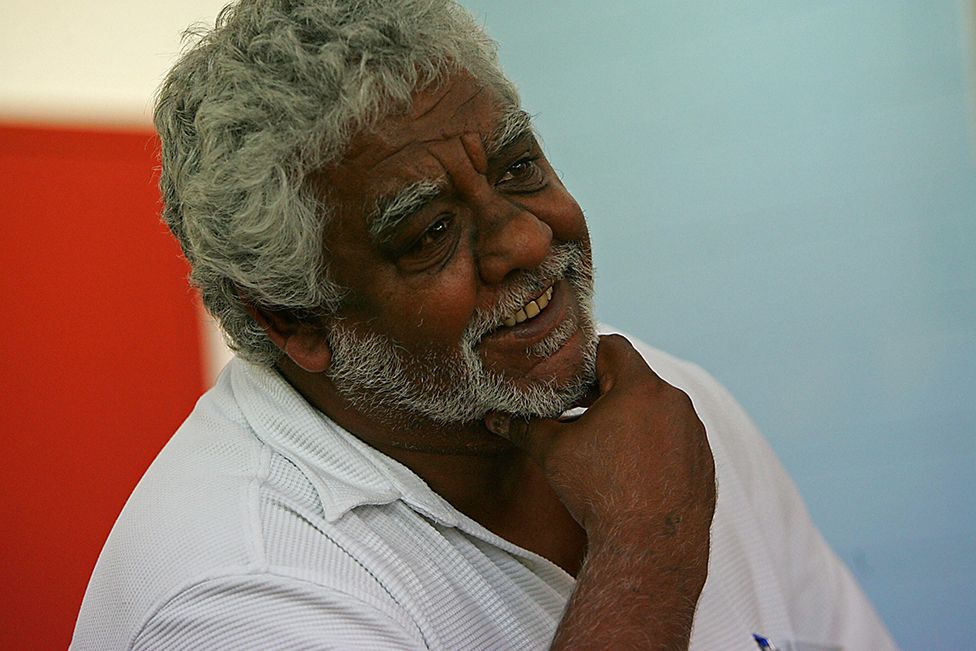
He and all his siblings, however, were forcibly removed after his mother’s death. The five oldest had whiter skin and were sent to Adelaide, where they were expected to “blend in”, he says. He and two brothers were taken 1,400km from Alice Springs to be brought up in a Methodist mission, where they were banned from speaking their language.
“We never knew who our family were,” he says. “It was a deliberate attempt to fragment the foundations of our lives, to the extent that we kept asking ourselves, ‘Who are we?'”
Dujuan is at least in no doubt about this. “I was born a little Aboriginal kid,” he tells Maya. “That means that I had a memory about Aboriginals. I just felt something, a memory. History. In my blood it runs.”
When William ran away from a children’s home he was placed in juvenile detention, which he describes as a “conveyor belt that led ultimately to the prison system”.
Only when he was 17 was he able to hitchhike back to Alice Springs, to be reunited with his father, three years before he died.
Although the policy of assimilation is no longer explicit, William says, the draconian rules governing education and welfare mean the system is still set against indigenous children. He sees many parallels between his story and Dujuan’s.

But Dujuan’s family come up with a strategy to keep him safe – the same one that was used in his mother’s case, before he was born. They send him to live in Borroloola, with his father, James Mawson.
“Kids like Dujuan go to detention centres. I wanted to move him away before that happened,” says his mum, Megan. “We Aboriginal parents do love and care about our kids.”
Despite the fact father and son have not seen each other for five years, it works out well. In Borroloola everyone pitches in, working the land and looking after cattle. Dujuan likes being able to spend weekends fishing or swimming in the family’s homelands – and there are no armed patrols on the street.
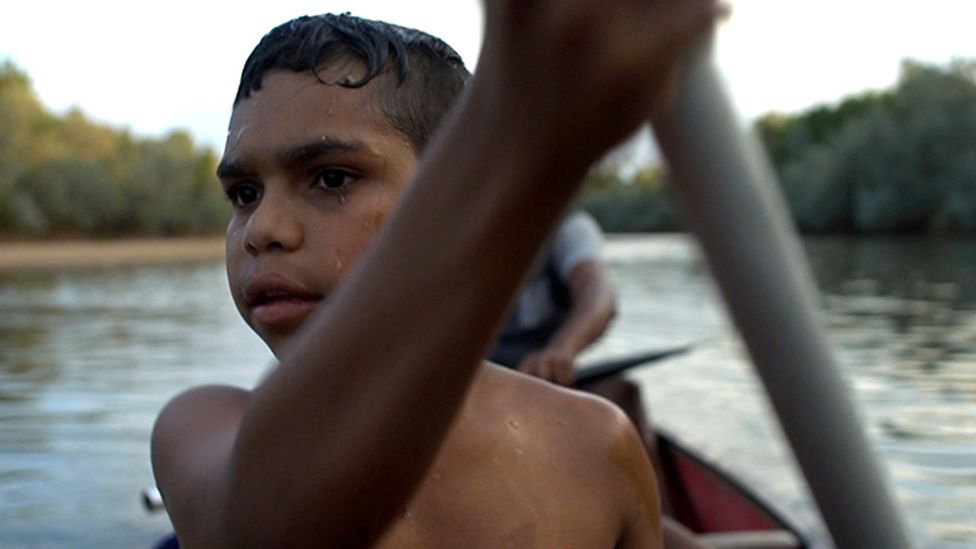
“Borroloola is like a little town where you are related to everybody. It’s better than Alice Springs, where there are many other kids that lead you into bad places, and lots of police that are watching over you,” he says.
He is also happier at the community’s small middle school, where 95% of students are indigenous.
“What I want is a normal life of just being me,” he says at the end of the film, still only 11 years old. “And what I mean by ‘me’ is, I want to be an Aborigine.”
Dujuan has since had to move out of Borroloola to finish high school. Now 14, he’s doing well, but he’s still not a huge fan. “It’s boring to be in school, but I know there is knowledge I need to learn there,” he writes via email.

In My Blood It Runs in the UK
The film is now being made available to schools in the UK, where one of the first to show it was Sunnydown school in Surrey, for boys with autism.
After the Black Lives Matter protests last summer, the head of English, Andrea Jensen, decided her year nine class would read Follow the Rabbit-Proof Fence, the true story of three Aboriginal girls removed from their families in 1931 who walked 1,600 km (995 miles) home. In My Blood It Runs touches on many of the same themes.
But the students could also relate to the experience of not fitting in at school.
“I felt the same way as Dujuan did,” says Elvin, 14. “Because when I was in primary school, I had to go into this special place for people with autism or physical disabilities. When I went out at break time, everyone would go away because they didn’t want to play with me.”
Matthew, 15, says he was made to use a different entrance. “They put me in a room all by myself and they covered the window so I couldn’t see anybody else.”
Dujuan says: “I made the film to give other Aboriginal kids hope and strength, but I think it can give all kids everywhere that too.
May 9th, 2021 at 11:42 pm
This is not just a national shame, it’s a crime against humanity, something that the United Nations inter alia must look into and ensure that the Australian government pay for their crimes. More than that, the aborigines must be paid restitution for what has been taken away from them by the white invaders over the centuries as well as the suffering they have had to endure by the rapacious ‘rulers’.
May 10th, 2021 at 1:59 am
This is nothing but the survival of the fittest which is the universal law. They used superior technologies like navigation and weapons then. The situation is not much different today, but with more methods added by humanity such as religion and psychology, to my mind.
Why we did not end up like this?. We had courageous people to engage with them physically. They did not want to continue killing and reduce their numbers also in the process, as these powers had global ambitions. But now we have several of them (Americans, Indians, Chinese and ME wahabis) joining hands to finish the job.
Stitch in time saves nine!.
May 10th, 2021 at 7:54 am
Is it only in Australia ? How about the American Indians and the First Citizens of Canada ? Have they had a fair deal ?
May 11th, 2021 at 4:03 am
Should we blame these western countries for what they have done not the red Indians who got into this pathetic situation?. They are showing these pictures either to get sympathy or for some other reason?. The Indians ( the Apaches of America, not the primitive aborigines) cut deals with the westerners and got into the situation.
Is it not the same situation happening right in front of our eyes?. All the politicos here since 1977 tried to cut deals with various countries and systematically reduce this once powerful and prosperous nation to become a pauper going with begging bowl without any shame and backbone. The officials of this country who got their free education at the expense of tax payers are also with these scoundrels. If not should an AG wait for two years until nearly a thousand charges have been found to arrest a 4/21 terrorist and prosecute the fellow?. That is not an honorable act AG.
May 11th, 2021 at 5:07 am
I forgot to add one more thing: there are more ways than one to fight a powerful force. This is one such thing that happened in far away Borneo around the time the Spanish were establish colonies in some parts of the world. When their Ships arrived in one part of the island the head hunters there observed from where they were taking their drinking water. Then they slowly poisoned it. The Spanish fellows fell ill one after the other. When they could not bear any longer they left never to return to the island.
So, how safe are the Chinese to plan to take their water from Sinharaja?.
Sinhalas never poisoned their water sources. But they in that mind set learnt a lesson at Alimankada.
Best thing for the Chinese is to come the proper way after sorting out their problems with the West. After all it was US that paved the way for their current prosperity. If not their global ambitions will end right here, in this land. They should keep that in mind if they do not want a Vietnam situation in Sri Lanka.